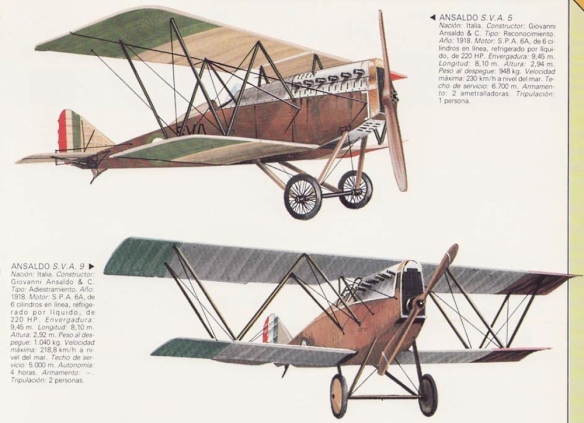The handsome Ansaldo craft conducted some of the longest and most impressive reconnaissance flights of World War I. They continued this tradition after the war and established many long-distance records.
In 1916 the Ansaldo firm began constructing a new high-performance fighter craft as a private company venture. It fell upon Umberto Savoia and Rodolfo Verduzio to design the prototype, which flew in March 1917. The SVA 4 was a good-looking biplane that employed “W”-shaped Warren struts along the wings, thus dispensing with the need for bracing wires. The wings themselves were of slightly unequal length, with the top possessing rakish ailerons and the bottom several degrees of dihedral. The slender fuselage was plywood-covered and tapered to a point past the cockpit, affording the pilot excellent rearward vision. Flight trials revealed that the SVA 4 possessed good performance, but it was too stable for fighter tactics. It therefore entered production as a reconnaissance craft and, in slightly modified form, joined the service in March 1918 as the SVA 5 Primo.
The single-seat Ansaldo designs accumulated a brilliant wartime career and were among the best aircraft of their class in the world. This fact was borne out by the many dangerous long-range reconnaissance missions seemingly performed with ease. On May 21, 1918, a pair of Primos crossed the Alps at high altitude, successfully photographed military installations at Friedrichshafen, Germany, and completed a flight of 435 miles. But the most famous Ansaldo mission happened on August 9, 1918, when six modified aircraft, accompanied by the poet Gabrielle di Annunzio, flew 300 miles to Vienna, dropped leaflets for half an hour, and returned after a 620-mile sojourn. Many other such flights were recorded.
The SVA 5s remained in service long after the Armistice. In 1920 five set out on an across-the-world venture from Rome to Tokyo, covering 11,250 miles in 109 flying hours. Production concluded in 1927, following a run of 2,000 machines.
Variants
SVA.1 – single prototype
SVA.2 – 65 production aircraft
ISVA – (Idroplane – “seaplane”) float-equipped version. 50 built for Italian navy
SVA.3 – AER-built SVA.4
SVA.3 Ridotto (“Reduced”) – fast-climbing interceptor variant for anti-Zeppelin defence. Some fitted with additional oblique-firing machine gun
SVA.4 – first major production version. Portside Vickers gun deleted to save weight for cameras.
SVA.5 – definitive production version
SVA.6 – prototype bomber version
SVA.8 – single prototype; nature unclear
SVA.9 – two-seat unarmed reconnaissance version with larger wings. Intended as pathfinder for SVA.5 formations, and as trainer
SVA.10 – two-seat armed reconnaissance version with 250 hp Isotta-Fraschini engine and fitted with single forward firing gun and a Lewis gun on a flexible mounting in the rear cockpit
Specifications (SVA.5)
General characteristics
Crew: one pilot
Length: 8.10 m (26 ft 7 in)
Wingspan: 9.10 m (29 ft 10 in)
Height: 2.65 m (8 ft 8 in)
Wing area: 24.2 m² (260 ft²)
Empty weight: 680 kg (1,500 lb)
Gross weight: 1,050 kg (2,320 lb)
Powerplant: 1 × SPA 6A, 150 kW (200 hp)
Performance
Maximum speed: 230 km/h (140 mph)
Endurance: 3 hours
Service ceiling: 6,000 m (19,700 ft)
Rate of climb: 5 m/s (980 ft/min)
Armament
2 × syncrhonised .303 Vickers machine gun
up to 90 kg (200 lb) of bombs
